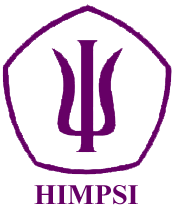Metode Pelatihan dengan Pendekatan Psikoedukasi untuk Meningkatkan Kemampuan Selective Attention pada Anak dengan Gangguan Pemusatan Perhatian dan Hiperaktivitas (GPPH)
Abstract
Full Text:
PDFReferences
Abidin, F. A., & Lubis, F. Y. (2015). Developmental and Psychoeducational Assesment for Preschool. Negotiating Practices of Early Childhood Education. https://www.researchgate.net/publication/342013364_Developmental_and_Psychoeducational_Assesment_for_Preschool
American Psychiatric Association. (2013). Diagnostic and Statistical Manual of Mental Disorders (5th ed.). Washington DC: American Psychiatric Publishing.
Bai, G., Wang, Y., Yang, L., & Niu, W. (2015). Effectiveness of a focused, brief psychoeducation program for parents of ADHD children: Improvement of medication adherence and symptoms. Neuropsychiatric Disease and Treatment, 11, 2721–2735. https://doi.org/10.2147/NDT.S88625
Barkley, R. A. (2018). Attention-Deficit Hyperactivity Disorder, Fourth Edition: A Handbook for Diagnosis and Treatment. New York: Guilford Publications.
Berk, L. E. (2012). Child Development. London: Pearson.
Dajek, E. R., & Brickenkamp, R. (2010). Polska standaryzacja Testu d2, testu badania uwagi R. Brickenkampa. Warszawa: ERDA.
Dawson, P., & Guare, R. (2018). Executive Skills in Children and Adolescents: A Practical Guide to Assessment and Intervention (3rd ed.). New York: Guilford Press.
Flick, G. L. (1998). ADD/ADHD Behavior-Change Resource Kit: Ready-to-Use Strategies and Activities for Helping Children with Attention Deficit Disorder. Hoboken: Wiley.
Flick, G. L. (2010). Managing ADHD in the K-8 Classroom: A Teacher’s Guide. Thousand Oaks: Corwin Press.
Graziano, A. M., & Raulin, M. L. (2020). Research Methods: A Process of Inquiry, 9th Edition (9th ed.). London: Pearson.
Grinspun, N., Nijs, L., Kausel, L., Onderdijk, K., Sepúlveda, N., & Rivera-Hutinel, A. (2020). Selective Attention and Inhibitory Control of Attention Are Correlated With Music Audiation. Frontiers in Psychology, 11(1109), 1–10. https://www.frontiersin.org/article/10.3389/fpsyg.2020.01109
Johnson, R. B., & Christensen, L. (2013). Educational Research: Quantitative, Qualitative, and Mixed Approaches. Thousand Oaks: SAGE Publications.
Kaufman, A. S., Raiford, S. E., & Coalson, D. L. (2016). Intelligent Testing with the WISC-V. Hoboken: John Wiley & Sons.
Kohls, L. R., & Brussow, H. L. (1995). Training know-how for cross cultural and diversity trainers. Duncanville: Adult Learning Systems.
Miller, M., & Hinshaw, S. P. (2010). Does Childhood Executive Function Predict Adolescent Functional Outcomes in Girls with ADHD? Journal of Abnormal Child Psychology, 38(3), 315–326. https://doi.org/10.1007/s10802-009-9369-2
Muna, N. R., Qodariah, L., Jatnika, R., Purwono, U., & Siregar, J. R. (2020). Design And Trial Selective Attention Computer-Based “Letvis” Program For Children With Attention Deficit Disorder. 589–595. https://doi.org/10.2991/assehr.k.200824.136
Natsheh, J. Y., & Shiflett, M. W. (2018). Dopaminergic Modulation of Goal-Directed Behavior in a Rodent Model of Attention-Deficit/Hyperactivity Disorder. Frontiers in Integrative Neuroscience, 12. https://www.frontiersin.org/article/10.3389/fnint.2018.00045
Qodariah, L. (2010). Program Latihan Perkusi Bagi Anak yang Mengalami Gangguan Pemusatan Perhatian (GPP): Studi Tentang Perancangan (Fase I) dan Uji Coba (Fase II) Program Latihan Perkusi Guna Meningkatkan Kemampuan Mempertahankan Atensi Bagi Anak Kelas 3 Sekolah Dasar yang Mengalami Gangguan Pemusatan Perhatian (GPP) [Thesis]. Universitas Padjadjaran, Bandung, Indonesia.
Richardson, M., Moore, D. A., Gwernan-Jones, R., Thompson-Coon, J., Ukoumunne, O., Rogers, M., Whear, R., Newlove-Delgado, T. V., Logan, S., Morris, C., Taylor, E., Cooper, P., Stein, K., Garside, R., & Ford, T. J. (2015). Non-pharmacological interventions for attention-deficit/hyperactivity disorder (ADHD)delivered in school settings: Systematic reviews of quantitative and qualitative research. Health Technology Assessment, 19(45), 1–470. https://doi.org/10.3310/hta19450
Rivera, D., Salinas, C., Ramos-Usuga, D., Delgado-Mejía, I. D., Vasallo Key, Y., Hernández Agurcia, G. P., Valencia Vásquez, J., García-Guerrero, C. E., García de la Cadena, C., Rabago Barajas, B. V., Romero-García, I., Campos Varillas, A. I., Sánchez-SanSegundo, M., Galvao-Carmona, A., Lara, L., Granja Gilbert, E. J., Martín-Lobo, P., Velázquez-Cardoso, J., Caracuel, A., & Arango-Lasprilla, J. C. (2017). Concentration Endurance Test (d2): Normative data for Spanish-speaking pediatric population. NeuroRehabilitation, 41(3), 661–671. https://doi.org/10.3233/NRE-172248
Sattler, J. M. (2018). Assessment of Children Cognitive Foundations and Applications. La Mesa: Jerome M. Sattler Publisher.
Schoeman, R., Albertyn, R., & Klerk, M. de. (2017). Adult attention-deficit hyperactivity disorder: Why should we pay attention? South African Journal of Psychiatry, 23(a1072), 6. https://doi.org/10.4102/sajpsychiatry.v23i0.1072
Sohlberg, M. M., & Mateer, C. A. (2010). APT-III: Attention process training : a direct attention training program for persons with acquired brain injury. Youngsville: Lash & Associates Publishing.
Stevens, C., & Bavelier, D. (2012). The role of selective attention on academic foundations: A cognitive neuroscience perspective. Developmental Cognitive Neuroscience, 2(1), S30–S48. https://doi.org/10.1016/j.dcn.2011.11.001
Steward, K. A., Tan, A., Delgaty, L., Gonzales, M. M., & Bunner, M. (2017). Self-Awareness of Executive Functioning Deficits in Adolescents With ADHD. Journal of Attention Disorders, 21(4), 316–322. https://doi.org/10.1177/1087054714530782
Sugiyono. (2018). Metode Penelitian Bisnis, Pendekatan Kuantitatif, Kualitatiff, Kombinasi, dan R&D (3rd ed.). Bandung: CV Alfabeta.
Sunanto, J., Takeuchi, K., & Nakata, H. (2006). Penelitian dengan Subjek Tunggal. Bandung: UPI Pres. https://psikologi.unimudasorong.ac.id/app/upload/file/metode-penelitian-subjek-tunggal.pdf
Wills-Jackson, C. (2019). A historical perspective of the field of emotional and behavioral disorders: A review of literature. International Journal of Psychology and Counselling, 11(8), 81–85. https://doi.org/10.5897/IJPC2019.0512
Xu, G., Strathearn, L., Liu, B., Yang, B., & Bao, W. (2018). Twenty-Year Trends in Diagnosed Attention-Deficit/Hyperactivity Disorder Among US Children and Adolescents, 1997-2016. JAMA Network Open, 1(4), e181471. https://doi.org/10.1001/jamanetworkopen.2018.1471
DOI: http://dx.doi.org/10.17977/um023v11i12022p10-24
Refbacks
- There are currently no refbacks.
Copyright (c) 2022 Jurnal Sains Psikologi

This work is licensed under a Creative Commons Attribution 4.0 International License.
Reference Manager :
|
Aliansi:
Plagiarism Checker :
This work is licensed under a Creative Commons Attribution 4.0 International License.




1.png)








